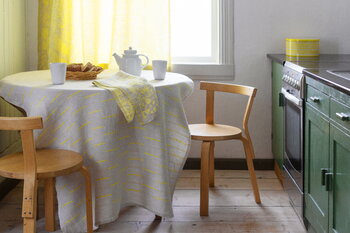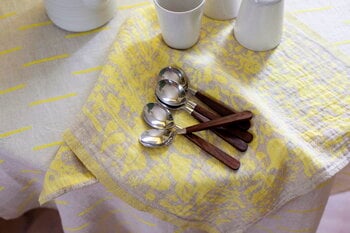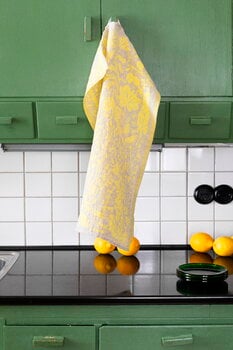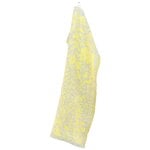The Villiyrtit hand towel, designed by Matti Pikkujämsä for Lapuan Kankurit, is adorned with a rich, flowing pattern showcasing the delicacies of Finnish nature – "villiyrtit" is Finnish for wild herbs. The pattern is mirrored on the other side in opposite colours. Made from 100% linen, the towel is absorbent, dries quickly and feels pleasant against the skin. The towel has been woven in Finland at the own weaving mill of Lapuan Kankurit.
Villiyrtit hand towel, yellow - linen
Lapuan Kankurit
Description
The Villiyrtit hand towel, designed by Matti Pikkujämsä for Lapuan Kankurit, is adorned with a rich, flowing pattern showcasing the delicacies of Finnish nature – "villiyrtit" is Finnish for wild herbs. The pattern is mirrored on the other side in opposite colours. Made from 100% linen, the towel is absorbent, dries quickly and feels pleasant against the skin. The towel has been woven in Finland at the own weaving mill of Lapuan Kankurit.
Product details (7)
- Material
- 100% washed European "Masters of Linen" linen
- Colour
- Linen, yellow
- Length
- 70 cm
- Width
- 48 cm
- Weight
- 100 g
- Care instructions
- Machine wash in 60°C
- Notes
- Hanging loop on the short side of the towel.
- Product ID
Designer
Matti Pikkujämsä (b. 1976) is a Finnish illustrator and graphic designer, who graduated from University of Art and Design Helsinki and has become known for his warm and humorous children’s book illustrations. He has also designed several book covers; prints for brands such as Samuji, Marimekko and Kauniste and illustrations for Finnish magazines and newspapers. In 2013 Pikkujämsä won the Rudolf Koivu illustration award and two years later the State Prize for Illustrations.
View all productsReviews (3)
4.33
Based on 3 reviews
-
A
Anonymous
Czechia
Super nice and great material. I was impressed so ordered even more.
352 days ago
-
A
Anne P
Helsinki, Finland
Kaunis!
366 days ago
-
A
Arja V
Miellyttävän pehmeä, uutenakin kuivaa hyvin.
135 days ago
Sustainability
The Product Sustainability Framework, our criteria of sustainable design, helps you find the most sustainable products in our selection. Read below which sustainability criteria this product has met.
Working conditions & labour 9/9
-
Equal opportunities for all employees
-
Commitment to UN Global Compact, fair compensation for all employees
-
Corporate responsibility requirements defined and communicated for suppliers
-
Systematic work for improved inclusion and well-being in the workplace
-
Transparent supply chain
-
Suppliers' compliance to a code of conduct ensured
-
Direct suppliers audited and certified
-
Compliance to the UN Guiding Principles on Business and Human Rights ensured in the supply chain
-
Support for community involvement in the supply chain
Eco-friendly production 9/9
-
Fair and resource-wise water-use in production
-
No incineration or landfilling of returned items
-
No use of endangered species as materials
-
No direct environmental emissions or waste (excl. GHGs) from production
-
The sustainability of direct suppliers' production is addressed and monitored
-
Production and material sourcing that respect biodiversity, animal rights, and natural ecosystems
-
Material-efficient and ecological packaging
-
Positive impact on nature’s well-being through operations that regenerate natural ecosystems
-
No potentially harmful chemicals used in own production
Climate impact 6/8
-
Company's direct greenhouse gas emissions identified and commitment to reduction
-
Product's carbon impact identified and commitment to reduction
-
Guidance on energy- and eco-efficient use of the product
-
Contribution to climate initiatives beyond the brand’s direct operations
-
Carbon footprint of the product calculated and goals set to reduce it
-
100 % renewable energy in own production and operations
-
Low-carbon or compensated transportation
-
Carbon neutral or carbon negative product
Sustainable materials 6/6
-
Sustainable and long-lasting material choices
-
No harmful or hazardous substances
-
Responsible raw material sourcing and production
-
Materials suited for circularity: monomaterials, recyclable finishings, renewable or recycled contents etc.
-
Ecological materials: natural, biodegradable, recyclable or recycled contents
-
Outstanding materials in terms of innovativeness, responsibility, sustainability and circularity: local production or sourcing, 100 % recycled content, C2C-certification etc.
Circular design 5/5
-
High aesthetic quality promoting long-term use of the product
-
Technically durable product design and material choices
-
Design for enduring life-long quality
-
Design and support for product maintenance, repair and upgradability
-
Innovative circular design solutions: circular service system, resale platform, remanufacturing, collection of used products, etc.














